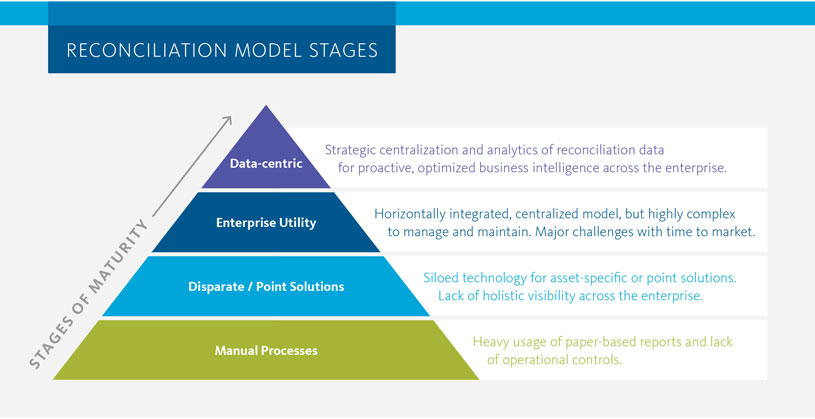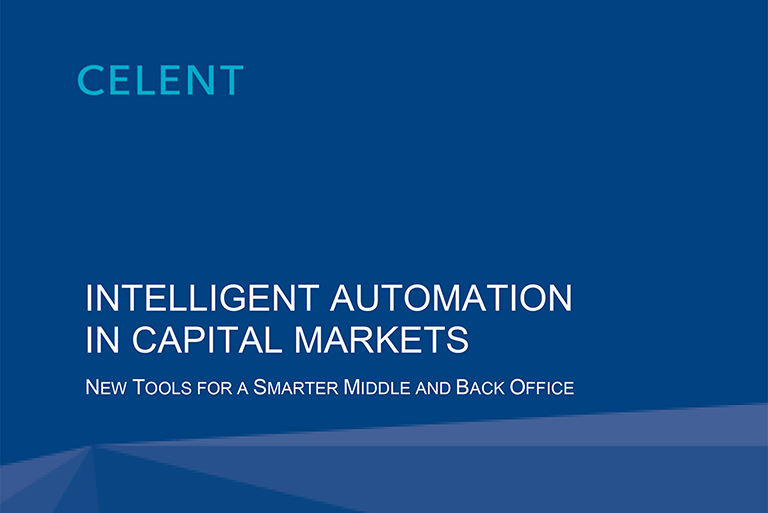Pathways to Operations Control Value
Capital markets transformation.

With increasing regulatory and market pressures in the capital markets industry, executives need access to accurate, enterprise-wide data for insightful decision-making. However, most firms find they spend too much time and too many resources collecting and reconciling data, and not enough time analyzing data to improve operations and mitigate risk. Explore how the current industry landscape is driving changes in reconciliation, and learn how a data-centric reconciliation model can serve as a catalyst for new ways of exploring data. Discover how establishing your firms reconciliation maturity level can help you transform your business.
Reconciliation as the catalyst
The continued confluence of regulatory changes, market pressures and an increased demand for data make this an especially challenging time for the capital markets industry. To navigate the changes impacting their firms, executives need access to accurate, enterprise-wide data that gives insights for better decision-making. However, most firms find they spend too much time and too many resources collecting and reconciling data, and not enough time analyzing data to improve operations and mitigate risk.
The root cause is that data is frequently scattered throughout the organization and siloed in myriad systems, making it difficult to validate its accuracy, mine it and derive business intelligence. Although firms have a growing volume of data, they lack a holistic enterprise view that allows them to make better business decisions and create a more flexible and dynamic organization that better adapts to new demands.
Perhaps nowhere is siloed data a more prevalent problem than in a firm’s reconciliation functions. Reconciliation touches internal and external data throughout every area of the firm, from core operations to credit, compliance, treasury and finance. Given its pervasive touch points, reconciliation can serve as a catalyst to help firms proactively leverage data for better business intelligence and actionable insight across organizations.
Current industry landscape—drivers for change
Traditionally known as a back-office function, reconciliation is often viewed as a necessary cost of doing business. However, that viewpoint is shifting as executives begin to consider reconciliation as a strategic asset. According to recent Aite Group research, these six trends are creating an increased focus on reconciliation:
![]()
REGULATORY PRESSURES
Central clearing measures outlined in Dodd Frank/EMIR are expanding firms’ reconciliation needs. This increased regulatory burden means firms must reconcile a higher number of internal and external data feeds, causing 40 percent of firms to say that compliance requirements are the biggest pressure on reconciliation.
![]()
INTRADAY REQUIREMENTS
Real-time processing to support intraday processing is becoming a business imperative; 68 percent of firms think real-time processing is important today.
![]()
LEGACY SYSTEMS
Many of the systems that support reconciliation require a technological refresh to handle today’s volumes and usability requirements. More than half of firms have a main reconciliation platform that is five or more years old, and 27 percent have a platform that is more than nine years old.
![]()
COMPLEXITY
Internal/external stakeholders are becoming more diverse, and organizations will need a more flexible platform to meet a broader, more diverse set of requirements.
![]()
Many firms have more than 50 employees dedicated to reconciliation, and one-quarter have more than 200 dedicated staff members. Firms have recognized that increasing staff numbers is not a cost-effective solution to increased reconciliation volume. Firms that centralize reconciliation are rewarded with cost savings:
- 56 percent of firms have achieved more than 20 percent savings
- 12 percent have realized more than 40 percent savings
- For almost half (48 percent) of firms, cost savings ranked as the top driver for establishing a central service for reconciliation
Currently, reconciliation is non-dynamic and unable to address new requirements quickly, whether they are market, organizational or regulatory-driven.
Data-centric reconciliation—the next frontier
Operational control processes are embedded within every area of an organization, from trading and core operations to financial and regulatory reporting. Seemingly minor data integrity issues can cause significant operational and financial risk. However, this is just the tip of the iceberg when it comes to the value that reconciliation can provide. Organizations need to take a holistic data-centric approach to their reconciliation model to reach the next frontier of business value.
Each internal reconciliation process creates a new and original dataset. An organization focused on data-centric reconciliation recognizes and cultivates this value.
As a result, data-centric reconciliation can serve as the catalyst for a new way of approaching how data is stored, accessed and analyzed enterprise-wide. This new proactive approach to applying data analytics to reconciliation data has the power to shift the fundamental value proposition from cost cutting to new financial value creation. In addition to providing a holistic view of data, a centralized reconciliation platform can reduce costs, minimize or even prevent breaks, and allow organizations to meet evolving regulatory requirements.
This new proactive approach to applying data analytics to reconciliation data has the power to shift the fundamental value proposition from cost cutting to new financial value creation.

Your reconciliation model—pathways to discovery
To gain business value from the data-centric reconciliation model, firms must first take a realistic look at their current reconciliation approach to assess its current value and the maturity level.
First, review the five characteristics below that define an organization’s reconciliation maturity model. Ask yourself the questions associated with each characteristic. Then fill out the assessment framework (below). This will help you chart a course to a more mature model:
- Knowledge management: Are you developing a learning organization with centers of excellence staffed and trained across the breadth of offered services? Are you removing single-person dependencies?
- Process management: Are you standardizing best practices, resource allocation and work prioritization? Does your reconciliations process meet the time-tomarket expectations of business partners?
- Technology management: Do you have the technology capabilities that can keep up-to-date? Is your technology a strategic asset that enables your organization to gain intelligent, “clean” business insights from data?
- Service management: Is your operational control function aligned to meet the service demands of your business partners and clients?
- Governance: Are firm, client and departmental priorities integrated with standardized oversight and control?
This framework enables an unbiased assessment of an organization’s current maturity level, and can serve as a catalyst toward the establishment of a strategic and integrated vision. An often-overlooked attribute of a successful operational control function is the interoperability of various components. Once firms understand their current reconciliation operations and compare them to the characteristics of a mature reconciliation model, they can define an executable vision that uses technology as an enabler for organization-wide goal achievement. Proper alignment between a firm’s current and future state can facilitate a path to the next frontier of value generation.

Data-centric reconciliation model— technology leverage
When moving to an advanced, high-performing datacentric reconciliation model, organizations need a stepwise jump in maturity. This may include leveraging key enabling technologies.
- Data-driven risk management: This involves using technology that can leverage reconciliation data as an asset to provide business intelligence and better risk mitigation around capital loss.
- Advanced technology: This will drive automation, helping firms mine historic user actions to create robotic process automation and machine learning.
- Robotic process automation (RPA) applied to a reconciliation ecosystem will help organizations deal with high-volume, repeatable and time-consuming tasks. For example, in some organizations, people must manually download and extract financial figures from web portals, and enter them into a different system that facilitates the reconciliation process. With RPA, software robots (known as bots) automatically capture and interpret existing applications for processing a transaction, manipulating data, triggering responses and communicating with other digital systems.
- Machine learning (ML) turns reconciliation data into an asset and a new opportunity. ML automatically discovers new reconciliation data patterns by mining historic user actions (learning). Once discovered, ML can make predictions, propose resolutions to reconciliation exceptions, and even adjust without intervention. ML also can facilitate a faster time to market on implementation and onboarding by automatically interpreting new data, and predicting the required reconciliation and matching requirements.
Help your organization to shift
A variety of factors, such as more demanding regulatory requirements, competitive market pressures and increased use of data analytics for decision-making, raises the stakes for all firms. Today’s organizations must harvest new technologies that can help them achieve their goals and can provide insights from across their enterprises to increase agility and the ability to react quickly to market changes.
When it comes to reimagining your reconciliation model, is your current in-house or vendor-provided technology an enabler or a constraint?
The road to a value-added reconciliation model starts with an assessment of an organization’s reconciliation maturity. Today’s leaders must know the answer so they can push the envelope to identify, cultivate and define implementable strategic plans that leverage reconciliation as a strategic value-added opportunity.
Helping a Leading Global Wealth Manager Evolve Its Operating Model
CHALLENGES: Client was challenged to meet increasing regulatory pressure and evolve its operations model.
- Customer protection and segregation challenges created reputational and regulatory risks
- Disparate reconciliation platforms by business line, geography and asset classes inhibited access to data required to manage the client’s operation efficiently
- Existing processes were not capable of meeting the new requirements of a shortened settlement cycle
SOLUTION: Partnering with Broadridge helped the organization introduce a new platform that allowed it to evolve its operating model.
- The new solution played a significant role in helping the client comply with the client protection program through reporting and auto-suspense of exceptions
- Transitioning to T+2 environment was made easier through a more efficient and consolidated platform and process
- The new platform now enables the firm to keep control of all user activity, including an improved audit trail of exceptions
- Periodic audit inquiries are made easier because historic reconciliation data and reporting is standardized and readily accessible
- Service management functions, including onboarding, are faster through the use of a more modern, user-friendly platform
- New platform provides the basis for future investment in advanced technology




